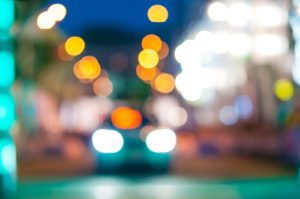
Driving Tips for People with Low Night Vision
Night driving can be a tricky prospect for even the most keen-eyed among us. Other cars move quickly and road conditions are unpredictable. Both of those conditions are exacerbated by low light levels. Difficult as it is under normal conditions, night driving becomes downright dangerous for people suffering from conditions that damage their night vision. But we have a few low night vision driving tips to make things a little easier.
A wide range of diseases, deficiencies, and syndromes can all contribute to poor night vision. Cataracts are perhaps the most well-known. These cloudy deposits commonly form in older eyes as proteins change shape and become light-scattering debris. People with cataracts experience a general drop in visual acuity but are particularly affected by glare. This can be troublesome during the day, but much worse at night. The unexpected shine of high beams can also easily blind an unprepared driver.
Strangely enough, LASIK surgery is also a known cause of night blindness. Patients who have undergone eye surgery can experience halos and blurring when exposed to bright light, either temporarily or permanently. They may have to deal with some of the same sensitivity to glare that cataract sufferers have.

And that’s just the start. Night blindness can be caused by progressive diseases such as retinitis pigmentosa, direct injury to the eye, and even nutritional deficiencies. For example, a low vitamin A intake can quickly bring on a case of night blindness.
Overall, night blindness is a serious disorder that is much more common than we’d like to imagine. For people with night blindness, the single best piece of advice we can offer is this: stay off the road at night until you’ve managed to find treatment for the condition.
However, we’re also aware that this isn’t always an option. Emergencies and other circumstances can put anyone behind the wheel at a moment’s notice. If you do find yourself driving in adverse light conditions, here are our low night vision driving tips.
Find the Right Lenses
Many night-blindness-causing conditions cause sensitivity to glare. Grabbing the right glasses can go a long way toward making them easier to cope with. Anti-glare treatment has been around for some time and may be your best friend for nighttime drives. Finding the right pair can instantly cut down on serious symptoms, such as the starbursts and halos that can appear around light sources.
Plan Your Route Carefully
Even if you do find yourself needing to head somewhere after dark, it’s up to you what route you take. Use your knowledge of local roads to plot a course that minimizes risks specific to vision-impaired night driving.
For example, if you know a particular road experiences a high volume of traffic during later hours, consider taking side roads. That is, if said side roads are decently lit. As bad as bright light can be, a total lack of streetlamps is almost certainly worse.
If possible, try to stick to streets you already know. Familiar surroundings are inevitably easier to handle than novel ones. If you’re forced to take a new route, then consider using Google Maps’ Streetview function to visually scout out reference points. It can forewarn you of areas – like big intersections – that might pose their own particular set of risks.
Maintain Your Vehicle
This goes for all drivers, but it’s doubly important for anyone coping with impaired night vision. Pay extremely close attention to the condition of your car. This obviously means performing routine maintenance, such as oil changes and tire replacements. But, it also calls for some extra TLC to account for poor vision.
Headlights are an obvious place to start. Ensure that your bulbs are in good repair and aren’t about to burn out on you. Periodic alignments can also help keep them in peak condition. Don’t neglect to maintain headlight covers. These haze over rapidly and many owners forget that they need consistent cleaning to stay transparent.
Carefully clean windows and mirrors, and keep defoggers on high if necessary. Dirty or smeared surfaces only make spotting obstacles and other drivers more difficult. Keeping them clean is a low-investment, high-yield way to boost driver safety.
Control Light Levels Inside Your Car
Use light judiciously inside your own car. It’s easy to pop a dome light on before leaving, then forget to turn it off when you’re on the move. However, it’s a bad move. Higher light levels inside your car can further compromise vision by making the eyes much slower to adapt to low light.
Some drivers may also want to consider dimming internal displays. This is actually a trick some professional drivers use to reduce eye fatigue. It can come in handy if brightly lit dials are aggravating your eyes. Of course, there’s a thin line between comfortable and difficult to see. When push comes to shove, be certain that you can actually read important details such as speed and gas levels.
Be Smart, Not Proud
Sometimes, a bit of caution goes a long way. Too many drivers adapt slowly to changes in their eyes. They maintain driving habits that, while appropriate for younger drivers, become actively dangerous to older ones.
First, stay in the slow lane, and don’t be too quick to pass. Changing lanes opens up blind spots for everyone. Blind spots are much worse for those of us with low vision.
Second, be realistic about your reaction time and your vision. Give cars in front of you a wide berth. Be aware of how far ahead you can see. If your headlights and vision combine to give you an extremely short range of vision, drive cautiously. Maintain speeds that allow you to stop within that distance, even if it’s a little narrower than you might like.
Low Night Vision Driving Tips for At Home
Night blindness isn’t always preventable, but some basic best practices can help many people mitigate or avoid it.
Diet is extremely important. Foods rich in vitamin A, such as leafy greens, give your eyes the nutrients they need to stay healthy. Frequent eye exams can also help detect problems early on, letting you address them before they seriously impact vision. As always, the more you do to maintain your vision earlier in life, the better your vision will be later on.
Our Rebuild Your Vision Ocu-Plus Formula Contains All 17 Vitamins, Minerals, and Herbal Supplements to Improve Your Eye Health!












Having had Lasik to help improve my eyes
after a wound on one of my eyes…
I can tell you I am suffering ever since the
operation. Night glare, dry eyes and loss of
my excellent near vision. I also suffer from
ongoing light sensitivity all day and night.
It affects everything I do.
This was not a passing result… after 6 years
I would have to say I am living with eyes damaged
by Lasik. And every night I wake up with dry eyes
as well. Forget about Lasik.
Teri
This is all great advice!
I just want to share a trick that has helped me overcome the excessive brightness of driving at night.
I wear clear polycarbonate safety glasses to reduce the intensity of the light. Due to polycarbonate’s unique filtering properties, there is enough reduction in some of the shorter wavelength’s of light that there is a noticeable effect. I have found it to be particularly true when looking at halogen lights, which are becoming more prevalent.
Thank you for allowing me to share!
Nice article Tyler. I would add that using Rain-X regularly greatly reduces glare during rain.
Rain x is a joke